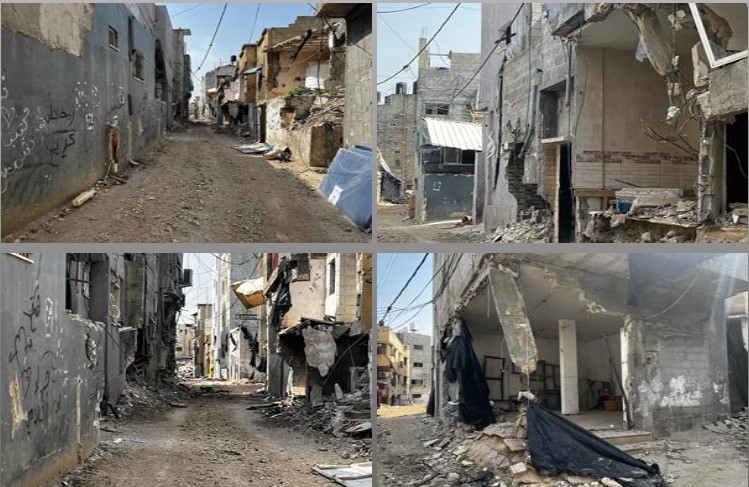
Tulkarm - Saba:
Since the morning hours of the first day of Eid al-Adha, Israeli enemy forces have begun large-scale demolition operations in Tulkarm camp, north of the occupied West Bank. This is part of their ongoing aggression against the Tulkarm camps, which has lasted 131 days.
Local sources reported, according to the Palestinian Information Center, that since the morning hours, five large bulldozers have been participating in the demolition of dozens of buildings, including more than 300 housing units, and dozens of commercial establishments in Tulkarm camp.
The enemy forces continue their aggression against the city of Tulkarm and its camp for the 131st consecutive day, and for the 127th day in the Nur Shams camp, amid a tight siege and ongoing attacks against the residents.
The occupation continues to impose a tight siege on the Tulkarm and Nur Shams camps, with forces deployed in alleys and neighborhoods, preventing residents from reaching their homes to check on them or retrieve their belongings, and opening fire directly on anyone who tries to approach.
The displaced families have called on the relevant authorities, specialists, and those responsible for the displacement file in the Tulkarm Governorate to help them cope with the ongoing displacement that has lasted for more than four months.
In recent days, demolitions have affected 20 residential buildings in the Nur Shams camp, as part of an Israeli plan to demolish 106 buildings in both camps (58 in Tulkarm camp and 48 in Nur Shams). This is intended to open roads and alter the geographical features of the two camps.
The ongoing aggression has resulted in the deaths of 13 citizens, including a child and two women, one of whom was eight months pregnant. It has also resulted in dozens of injuries and arrests, as well as widespread destruction of infrastructure, homes, shops, and vehicles.
The escalation has displaced more than 4,200 families from the two camps, representing over 25,000 citizens. It has also completely destroyed over 400 homes and partially damaged 2,573 others. Meanwhile, the entrances to the two camps remain blocked with barriers, transforming them into almost lifeless areas.
Since the morning hours of the first day of Eid al-Adha, Israeli enemy forces have begun large-scale demolition operations in Tulkarm camp, north of the occupied West Bank. This is part of their ongoing aggression against the Tulkarm camps, which has lasted 131 days.
Local sources reported, according to the Palestinian Information Center, that since the morning hours, five large bulldozers have been participating in the demolition of dozens of buildings, including more than 300 housing units, and dozens of commercial establishments in Tulkarm camp.
The enemy forces continue their aggression against the city of Tulkarm and its camp for the 131st consecutive day, and for the 127th day in the Nur Shams camp, amid a tight siege and ongoing attacks against the residents.
The occupation continues to impose a tight siege on the Tulkarm and Nur Shams camps, with forces deployed in alleys and neighborhoods, preventing residents from reaching their homes to check on them or retrieve their belongings, and opening fire directly on anyone who tries to approach.
The displaced families have called on the relevant authorities, specialists, and those responsible for the displacement file in the Tulkarm Governorate to help them cope with the ongoing displacement that has lasted for more than four months.
In recent days, demolitions have affected 20 residential buildings in the Nur Shams camp, as part of an Israeli plan to demolish 106 buildings in both camps (58 in Tulkarm camp and 48 in Nur Shams). This is intended to open roads and alter the geographical features of the two camps.
The ongoing aggression has resulted in the deaths of 13 citizens, including a child and two women, one of whom was eight months pregnant. It has also resulted in dozens of injuries and arrests, as well as widespread destruction of infrastructure, homes, shops, and vehicles.
The escalation has displaced more than 4,200 families from the two camps, representing over 25,000 citizens. It has also completely destroyed over 400 homes and partially damaged 2,573 others. Meanwhile, the entrances to the two camps remain blocked with barriers, transforming them into almost lifeless areas.